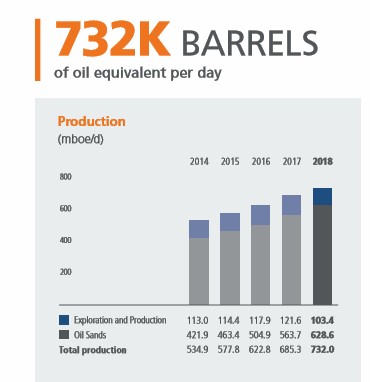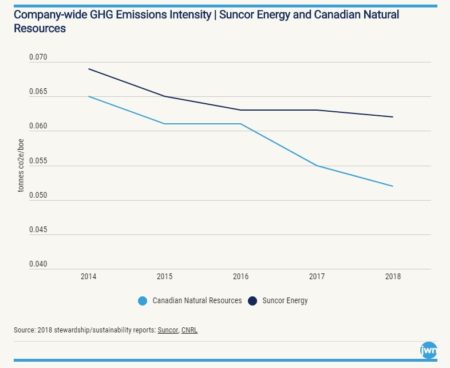July 23, 2019 – Yesterday, two of Canada’s largest oil and natural gas producers announced reductions in greenhouse gas (GHG) emission intensity across their global operations.
What is being measured?
The amount of GHGs produced for each unit of production. In the case of oil and natural gas, the industry measures GHGs per BOE (barrel of oil equivalent).
The two reporting companies, Suncor Energy, and Canadian Natural Resources released their latest sustainability data highlighting environmental and safety performance throughout all aspects of their operations including supply chains.
Both reported reductions as seen in the comparative line graph displayed below.
For Suncor GHG intensity per BOE dropped by 10% since 2014. And for Canadian Natural Resources, the drop was 20%.
Should we be happy about this type of sustainability reporting? Yes and no.
If the measurable metric, the amount of carbon dioxide (CO2) or equivalent during the production process, is the most important item to measure, then I would say yes, we should be happy.
But in both cases, the companies are being dishonest because they don’t talk about the total units of production, which is where the real problem lies. You see, we can reduce carbon intensity throughout a production process, but if we increase the number of units of production, then the overall total of CO2 or equivalent GHG may continue to rise which turns out to be exactly the case when you start drilling down on reported numbers.
Suncor according to its 2018 annual report, produced 534.9 thousand BOE daily in 2014, and 732 thousand daily in 2018. That’s a 36.8% increase which when compared to the 10% intensity drop per BOE means overall carbon emissions from Suncor increased substantially in the five reporting years (see graph below).

Meanwhile, when you drill down on Canadian Natural Resources data to compare daily BOE in several annual reports it shows an increase from 2014 to 2018 in daily output from 790 thousand to 1.079 million or a 36.6% increase in BOE units. Compared to 20% carbon intensity reduction per BOE over the same time period makes it pretty clear that, like Suncor, Canadian Natural Resources is also producing more GHG emissions over the last five years on record.
In public statements both companies have set goals to reduce GHG intensity in their operations: Suncor by 30% from 2014 to 2030, and Canadian Natural Resources to net-zero emissions in its oil sands operations (not other forms of BOE equivalents). But in reporting emission reduction figures yesterday, both companies focused on intensity, and not on overall emissions. And it is obvious why because neither is achieving net reductions. In fact, Suncor reported its GHG emissions increased by 11% to 21.9 million tons of CO2 in 2018, while Canadian Natural Resources didn’t report on this number at all. It did, however, state it has “aspirational goals” to meet net-zero emissions from oil sands operations, citing the Quest facility, a carbon capture and sequestration (CCS) installation of which it has a 70% ownership stake. Quest, in its most recent report, announced it had achieved a CCS milestone reaching 4 million tons in captured methane emissions at the source as of May of this year.
And just in case you missed it, a few days ago I posted information on this blog site about a University of Washington in Seattle course called “Calling Bullshit,” which teaches students to spot the misinformation, lies, and distortions in graphs, reports and corporate announcements. Well the kind of information seen coming from Suncor and Canadian Natural Resources can certainly be a great example of bullshit. To measure intensity when you are trying to solve the anthropogenic climate change problem is bullshit, particularly since the overall goal for humanity is to reduce GHG emissions which means if you keep expanding daily BOE volumes and spew even more into the atmosphere, we can never bend the carbon curve downward and meet the global goals established in the Paris Climate Agreement of 2015.









